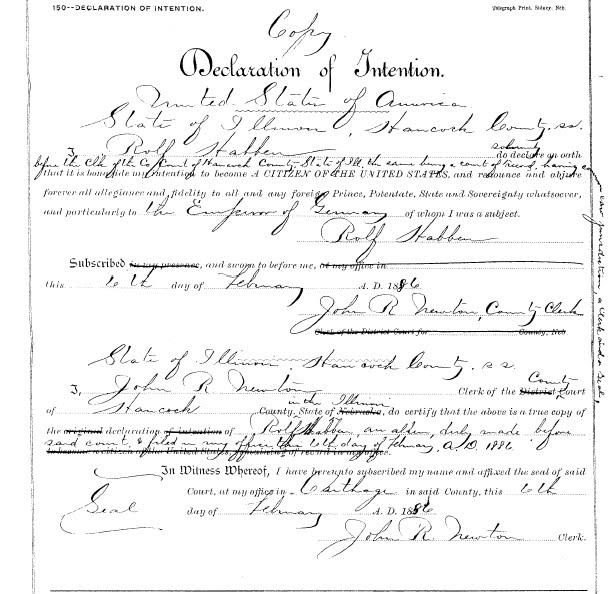 One of the necessary items of citing genealogical sources is what copy of a document was actually used.
One of the necessary items of citing genealogical sources is what copy of a document was actually used.The image shown here is a handwritten copy of the Declaration of Intent for Rolf Habben, made out in Hancock County, Illinois, in 1886. This image was made from a photocopy of the copy which was contained in the homestead file.
Rolf Habben had a handwritten copy of his declaration of intention.
At one point in time, Hancock County had the originals of these declarations of intent.
There was the “real deal” at the county courthouse, the copy Habben had, and the copy made from Habben’s copy that was included as a part of his homestead file.
Then there is the photocopy I have (of the copy in the homestead file).
Then there’s this image I made to post on the website.
Then there’s the PDF file I made that contained a high quality scan of the entire homestead file (one of the documents in that file was the declaration of intent).
Which copy of a record do you have?

4 Responses
This post gives us something to keep in mind when documenting info. For instance, I saw the original 1776 marriage record for my ancestors in a Virginia county courthouse. I obtained a copy while there and have made numerous copies from that copy. Unfortunately, I didn’t know enough at that time to have someone in the courthouse certify my copy.
Now that many records are on line it becomes more difficult to document the origin and copies of a record.
Marion County, Oregon, microfilmed old deeds. The microfilm is almost unreadable. I have access to old photocopies of the deeds (white writing on black background) that is much more readable but still presents problems. FHL has digitized the deeds, and they are clear as a bell. Or at least as much as clerks’ handwriting allows. These FHL copies are now my go-to documents.
A point to keep in mind about old deed books in courthouses – they are almost always a clerk’s copy. The land owner had the original deed.
Deb’s correct. And the old ones are handwritten copies and not mechanical reproductions.